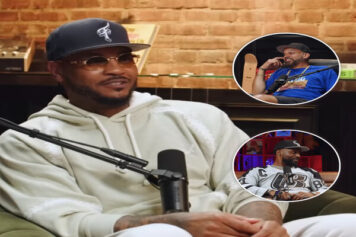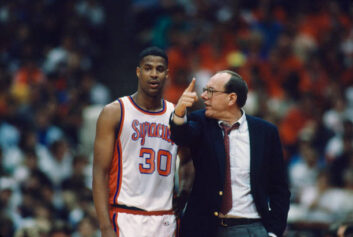Last year’s NCAA Tournament was supposed to be all about the Duke Blue Devils and Coach K’s trio of NBA lottery projected studs; Zion WIlliamson (No. 1 overall), RJ Barrett (No. 3 overall) and Cam Reddish (No. 10 overall).
It was expected that Duke’s freshman would run through the lesser competition and be mentioned alongside Georgetown’s Patrick Ewing, Reggie Williams and Michael Graham, Michigan’s Sean Higgins, UCLA’s Toby Bailey, North Carolina’s Michael Jordan, Arizona’s Mike Bibby, Kentucky’s Anthony Davis and Louisville’s Pervis Ellison as freshman who dominated March Madness.
But, in my opinion, there was no freshman whose Final Four and Title game performance shined brighter than current Portland Trailblazers veteran Carmelo Anthony’s.
Birth of An NBA Scoring Machine
Melo, though most often associated with his hometown of West Baltimore, Maryland, was introduced to the game on the asphalt of New York City. His father, Carmelo Iriate, was a playground baller who, before moving to the Big Apple, grew up on the west coast of Puerto Rico.
Melo was born in 1984 and, for the first eight years of his life, lived in Brooklyn’s Red Hook Projects. His father was felled by liver cancer and transitioned when Melo was still a toddler, but he passed on an enduring legacy.
“My father was a ballplayer and I still have clips of articles about him and some leagues he played in,” Melo told me during a conversation I had with him a few years ago. “He was a 6-foot-5 scorer. It runs in our family.”
Before Mary Anthony moved her four children to Baltimore, Melo was an ardent St. John’s hoops fan. He also counted Brooklyn native Bernard King, the Knicks’ small forward extraordinaire and scoring machine, among his boyhood idols.
Upon moving to Baltimore, he frequented the outdoor courts in his new neighborhood on the west side of town, which was known as “The Pharmacy” due to the thriving narcotics trade.
The Myrtle Avenue that Carmelo settled into was far removed from West Baltimore’s glory days, where Jazz and entertainment giants like Satchmo, aka Louis Armstrong, or the raw, guttural genius of cats like Screamin’ Jay Hawkins packed the Royal Theater and the city’s other Chitlin Circuit landmarks.
The sparkling marble steps of once-elegant homes, as well as the fabric of the family unit, were in sad disrepair during Melo’s transition into adolescence.
The drug culture, and its associated violence, had turned the once-proud manufacturing and blue collar enclave into one of the nation’s murder capitals. In the shadows of Ravens Stadium and Camden Yards, parts of West Baltimore resemble war-torn, third world disasters.
The neighborhood where Carmelo grew up was ground zero for H.B.O’s phenomenal series, The Wire. But Mary Anthony would not allow the negative forces to swallow her son up without a fight. She insisted that his grades be maintained, especially when he showed glimpses of tantalizing athletic potential during adolescence.
He signed with Syracuse as a skinny, 6-foot-7 junior at Towson Catholic High School.
“He was basically a regional recruit,” Syracuse assistant coach Troy Weaver told SI in 2002. “But then in the summer he just blew up nationally.”
In the fall, he transferred to prep hoops powerhouse Oak Hill Academy and, taking his profile outside of Baltimore, became a top-five national recruit. Sequestered in the rural Virginia mountains, he added 20 pounds of muscle and took his game to another level.
Melo led Oak Hill to a 32-1 record – including a victory over the Akron, Ohio, St. Vincent-St. Mary squad led by LeBron James – and averaged 22 points and seven rebounds per game. He thought about going pro, but his mom wanted him to get a taste of college life. The housekeeper at the University of Baltimore was unfazed about the potential millions her son was poised to earn.
“I didn’t want him to go to the NBA,” Mary Anthony told Sports Illustrated in 2002. “When you get all that fame and fortune, honey, you become a man, right then and there. I wanted my son to have a chance to be 18 years old.”
His first basket for the Orangemen was a dunk against Memphis, and Melo proceeded to score 27 points or better in his first three college games. He led Syracuseuse with 22 points and 10 rebounds per game during the regular season.
Then came Melo’s March Madness, where he sewed one of the most dominating freshman performances ever seen into the rich tapestry of the NCAA Tournament.
In the East Regional Final against Oklahoma, he had a double-double with 20 points and 10 rebounds in the 63-47 victory.
Against T.J. Ford and the University of Texas in the ‘03 Final Four (which was the first time casual fans ever heard the name of Marquette’s super duper star, Dwyane Wade), Melo set a record for the most points ever scored by a freshman in a national Semi-Final.
He exploded on the grand stage with 33 points, making 12 of 19 shots, and collected 14 rebounds in the 95-84 victory.
The One And Done Specialist
In the 2003 National Championship, Melo – with some assistance from Gerry McNamara, Hakim Warrick, Billy Edelin and Kueth Duany – delivered coach Jim Boeheim’s first NCAA title with a 20-point, 10-rebound, 6-assist performance in Syracuse’s 81-78 victory over Kirk Hinrich and Nick Collison’s Kansas Jayhawks crew.
The Sporting News gushed that “…Anthony played the college game better than any freshman in NCAA basketball. Ever.”
Boeheim told SI that Melo was “The best player I’ve ever coached.” He garnered First Team All-American honors, was the Big East Rookie of the Year and the Final Four’s Most Outstanding Player.
For those few weeks in March of 2003, Carmelo Anthony solidified himself as the greatest one-year player in college basketball history, the cat who gave every player behind him the one-and-done wet dream.
For those who watched him as a college freshman, especially during the NCAA Tournament, we’ll never forget how he put the legacy of his coach and an entire program on his young shoulders, delivering a title and stretch of performances that will live on forever.



